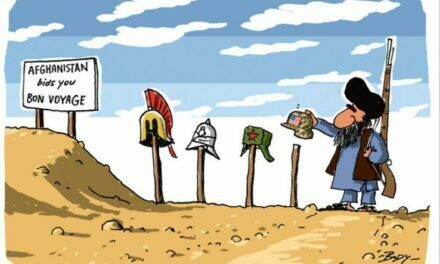
HORIST: Pssst! We are at war in Afghanistan … in case you hadn’t noticed
War has pock-marked the history of the United States since we won our freedom from England following the Revolutionary War (1776). The Brits tried to get us back in the War of 1812. We expanded the United States into the southwest in the Mexican War (1846-1848). We almost split in the Civil War (1860-1865). In the very brief Spanish American War (1898), we gained control – some temporary — over a lot of off-shore real estate including Guam, Puerto Rico, Cuba and the Philippines.
There then was the “war to end all wars” – but didn’t – World War I (1914-1918), followed a couple decades later by World War II (1939-1945). We next fought in Korea (1950-1953) in a war that has not officially ended to this day and was the first time America was drawn into an armistice stalemate. America then entered the Vietnam War (1955-1975), Americas longest war at the time and the first one we clearly lost.
In between these major conflicts were a number of mini-wars such as the First Barbary War (1801-1805), the Second Barbary War (1815), the Ivory Coast War (1842), the Fiji Expeditions, as they were called, of 1855 and 1858, respectively, and a series of Indian wars throughout the 1800s.
America’s modern war history is centered on the Middle East – a region of the world that has been embattled since the end of World War II, and some say, since the Crusades. The United States entered the perennial desert conflicts – which had transmuted into a series of battles against world terrorism — with the Gulf War (1990-1991), which reignited as the Iraq War (2003) and then expanded to the Syrian conflict (2011—present but ending soon).
Then there is Afghanistan. It not only exceeds Vietnam as America’s longest military engagement (2001-present), but it seems like America’s most unnoticed war. The most avid consumer of news will find it difficult to find any reports “from the front.” Where are the battles being raged? Or are they being raged? Who is winning?
Yes, there are occasional reports of a terrorist-type bombing in Kabul or the deaths of American soldiers. But such reports are given a few seconds between President Trump’s latest tweet and the weather forecast. In the meantime, thousands upon thousands of combatants and civilians continue to perish every year.
By the time you read about this, at least 48,000 will have died on the allied side and at least 75,000 among the Taliban and its allies. 2,500 of those killed were American servicemen and women – including this writer’s Marine grandson.
America’s commitment and determination in Afghanistan has been a rollercoaster of conflicting policy decisions. In 2001, under President Bush, we went in for what was believed to be a short and decisive routing of the remnants of the Taliban. As Bush was departing from the Oval Office in 2008, things in Afghanistan were not going well. It already had dragged out longer than anticipated and there was no victory in sight.
President Obama committed to a military surge in Afghanistan – meaning more soldiers, more weapons and more time. As the newspapers noted at the time, Obama, with that surge, took ownership of the war in Afghanistan – contrary to his ill-fated decision to withdraw prematurely from Iraq.
But instead of following through, Obama developed a policy of leading from behind – essentially allowing others to handle the problem. Obama issued orders that more narrowly defined our “rules of engagement” – essentially tying the hands of the Pentagon in pursuing the war aggressively. Under the more restrictive rules, the number of bombs released dropped from 2,800 in 2013 to less than 1,000 in 2015. In the last year of his presidency, Obama allowed the military to do its job and the number of bombs dropped rose to 1,300 in 2016.
Upon taking office, President Trump immediately changed the rules of engagement to allow the military to make more strategic and tactical decisions. This led to an increase in bombs dropped to 4,400 in 2017, including the so-called Mother of All Bombs – the most powerful device short of a nuclear weapon. Based on the current projection, the number of bombs that will be dropped in 2018 is expected to exceed 5,000. Despite the record number of bombs, the civilian death rate has dropped in 2017.
In many ways, Afghanistan is a war the United States cannot afford to lose. With close ties to Iran, and a history of Muslim Jihadism, a Taliban victory would create one more Islamic terrorist state to come under the Middle East hegemony of Iran – just as Syria is becoming –and the future role of Iraq is still uncertain. An Iran powerhouse in the Gulf region, would increase the influence of both Russia and China – and threaten the security of Saudi Arabia, Israel and Egypt, as well as the United States.
And yet … we the people are left in the dark by a disinterested media establishment. Where are the daily reports on the progress or setbacks in Afghanistan that had dominated the news in virtually every other American conflict? Where are the maps showing the regions of conflict? Where are the battles being fought? What is happening? Where are the articulated goals and objects – short term and long run?
Perhaps the most important question is … why is the world’s largest, most powerful and most technically advanced military being bogged down in wars against people who fight with machine guns on the backs of pick-up trucks?
So, there ‘tis.
Editor’s note: As PBP has written many times, our primary interest and our primary target should be the opium fields and supply chains. Afghanistan continues to produce 80% of the world opium supply. The terrorist insurgency in Afghanistan receives more than half of their funding from the opium trade. In short, follow the money. The insurgency cannot fight without it.
As we saw in Colombia, insurgent forces frequently offer security to the producers of illicit drugs in exchange for money and weapons to fight their battles. Druglords are expert at keeping insurgents on a string and prolonging instability to protect their products. In the case of Colombia, that symbiotic relationship lasted for decades.


























I my lifetime all that I have known has been conflict in one place or another.
In my opinion whoever controls the poppy fields of this earth controls its destiny.
The people who get in their way must be eliminated.
The main stream media of today is only interesting in one thing and that is trashing The President of the United States Donald Trump.
I pray President Trump prevails.
I agree with you completely The MSM needs to report the news and stop making it up and twisting and distorting things and go back to serving the public which they used to do years ago. They are now so hated and distrusted by the majority of Americans it will take a century to ever trust them again. And that’s only if they start trying to change TODAY! They make us sick to our stomachs, ex. Acosta!